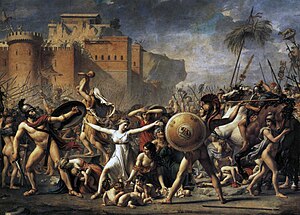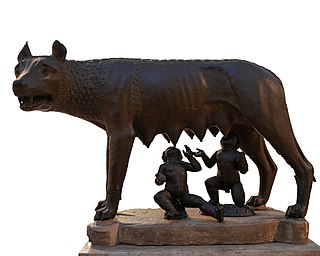
In Roman mythology, Romulus and Remus are twin brothers whose story tells of the events that led to the founding of the city of Rome and the Roman Kingdom by Romulus, following his fratricide of Remus. The image of a she-wolf suckling the twins in their infancy has been a symbol of the city of Rome and the ancient Romans since at least the 3rd century BC. Although the tale takes place before the founding of Rome around 750 BC, the earliest known written account of the myth is from the late 3rd century BC. Possible historical bases for the story, and interpretations of its local variants, are subjects of ongoing debate.

In Roman mythology, Amulius was king of Alba Longa who ordered the death of his infant, twin grandnephews Romulus, the eventual founder and king of Rome, and Remus. He was deposed and killed by them after they survived and grew to adulthood.

Numa Pompilius was the legendary second king of Rome, succeeding Romulus after a one-year interregnum. He was of Sabine origin, and many of Rome's most important religious and political institutions are attributed to him, such as the Roman calendar, Vestal Virgins, the cult of Mars, the cult of Jupiter, the cult of Romulus, and the office of pontifex maximus.
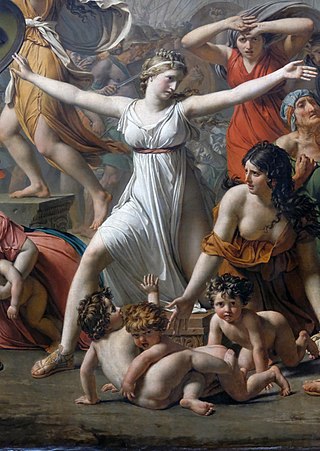
In Roman mythology, Hersilia was a figure in the foundation myth of Rome. She is credited with ending the war between Rome and the Sabines.

The Sabines (, SAY-bynes,, SAB-eyens; Latin: Sabini; Italian: Sabini were an Italic people who lived in the central Apennine Mountains of the ancient Italian Peninsula, also inhabiting Latium north of the Anio before the founding of Rome.

Dionysius of Halicarnassus was a Greek historian and teacher of rhetoric, who flourished during the reign of Emperor Augustus. His literary style was atticistic – imitating Classical Attic Greek in its prime.

Tullus Hostilius was the legendary third king of Rome. He succeeded Numa Pompilius and was succeeded by Ancus Marcius. Unlike his predecessor, Tullus was known as a warlike king who, according to the Roman historian Livy, believed the more peaceful nature of his predecessor had weakened Rome. It has been attested that he sought out war and was even more warlike than the first king of Rome, Romulus. Accounts of the death of Tullus Hostilius vary. In the mythological version of events Livy describes, he had angered Jupiter who then killed him with a bolt of lightning. Non-mythological sources on the other hand describe that he died of plague after a rule of 32 years.

According to the Roman foundation myth, Titus Tatius, also called Tatius Sabinus, was king of the Sabines from Cures and joint-ruler of the Kingdom of Rome for several years.

The Lacus Curtius was a pit or pool in the ground in the Forum Romanum. The area where the Forum would later be built was originally likely a lake, as the area it was in is known to have been surrounded by brooks and marshes. One part of the area was never drained, but gradually became smaller until only a basin, known as the Lacus Curtius, was left. Its nature and significance in Rome's early history is uncertain, and several conflicting stories exist about its history.

In Roman legend, Tarpeia, daughter of the Roman commander Spurius Tarpeius, was a Vestal Virgin who betrayed the city of Rome to the Sabines at the time of their women's abduction for what she thought would be a reward of jewelry. She was instead crushed to death by Sabine shields and her body cast from the southern cliff of Rome's Capitoline Hill, thereafter called after her the Tarpeian Rock.

The Ficus Ruminalis was a wild fig tree that had religious and mythological significance in ancient Rome. It stood near the small cave known as the Lupercal at the foot of the Palatine Hill and was the spot where according to tradition the floating makeshift cradle of Romulus and Remus landed on the banks of the Tiber. There they were nurtured by the she-wolf and discovered by Faustulus. The tree was sacred to Rumina, one of the birth and childhood deities, who protected breastfeeding in humans and animals. St. Augustine mentions a Jupiter Ruminus.

The Rape of the Sabine Women, also known as the Abduction of the Sabine Women or the Kidnapping of the Sabine Women, was an incident in the legendary history of Rome in which the men of Rome committed a mass abduction of young women from the other cities in the region. It has been a frequent subject of painters and sculptors, particularly since the Renaissance.

Romulus was the legendary founder and first king of Rome. Various traditions attribute the establishment of many of Rome's oldest legal, political, religious, and social institutions to Romulus and his contemporaries. Although many of these traditions incorporate elements of folklore, and it is not clear to what extent a historical figure underlies the mythical Romulus, the events and institutions ascribed to him were central to the myths surrounding Rome's origins and cultural traditions.
Monte Cavo, or less often, "Monte Albano," is the second highest mountain of the complex of the Alban Hills, near Rome, Italy. An old volcano extinguished around 10,000 years ago, it lies about 20 km (12 mi) from the sea, in the territory of the comune of Rocca di Papa. It is the dominant peak of the Alban Hills. The current name comes from Cabum, an Italic settlement existing on this mountain.

Alba Longa was an ancient Latin city in Central Italy in the vicinity of Lake Albano in the Alban Hills. The ancient Romans believed it to be the founder and head of the Latin League, before it was destroyed by the Roman Kingdom around the middle of the 7th century BC and its inhabitants were forced to settle in Rome. In legend, Romulus and Remus, founders of Rome, had come from the royal dynasty of Alba Longa, which in Virgil's Aeneid had been the bloodline of Aeneas, a son of Venus.
Hostus Hostilius was a Roman warrior in the time of Romulus, and the grandfather of Tullus Hostilius, the third Roman king.

The gens Horatia was a patrician family at ancient Rome. In legend, the gens dates back to the time of Tullus Hostilius, the third King of Rome. One of its members, Marcus Horatius Pulvillus, was consul suffectus in 509 BC, the first year of the Republic, and again in 507. The most famous of the Horatii was his nephew, Publius Horatius Cocles, who held the Sublician bridge against the army of Lars Porsena circa 508 BC.

The gens Curtia was an ancient but minor noble family at Rome, with both patrician and plebeian branches. The only member of the gens invested with the consulship under the Republic was Gaius Curtius Philo, in 445 BC. A few Curtii held lesser magistracies during the Republic, and there were two consuls suffectus in imperial times. However, the gens is best remembered from a series of legends dating from the traditional founding of the city to the early Republic.
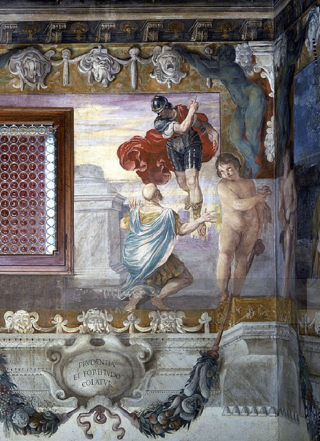
Proculus Julius is a figure in the legendary history of the Roman Kingdom. His reported visitation by King Romulus, Rome's putative founder and first ruler, shortly after the king's disappearance convinces the people of Rome to accept Romulus' divinity and the claims by the senate that he had been taken up by the gods in a whirlwind.
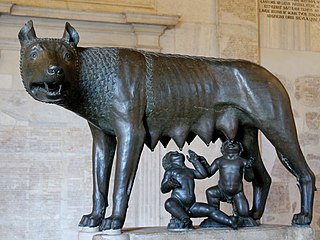
In the Roman foundation myth, a she-wolf was an Italian wolf who nursed and sheltered the twins Romulus and Remus after they were abandoned in the wild by decree of King Amulius of Alba Longa. She cared for the infants at her den, a cave known as the Lupercal, until they were discovered by a shepherd, Faustulus. Romulus would later become the founder and first king of Rome. The image of the she-wolf suckling the twins has been a symbol of Rome since ancient times and is one of the most recognizable icons of ancient mythology.

